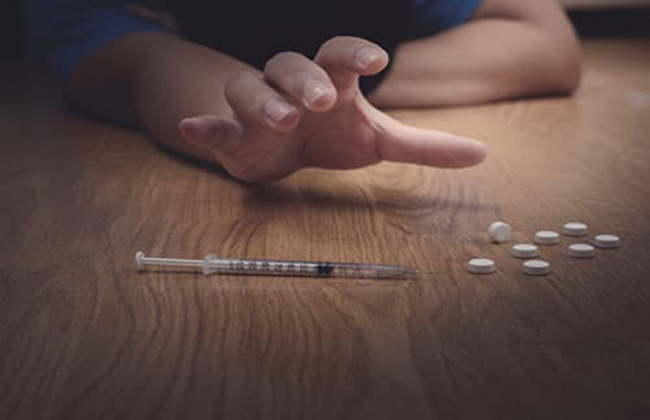
LSD (Lysergic acid diethylamide) is a semi-synthetic hallucinogenic drug. It is manufactured from lysergic acid which is found in the ergot fungus that grows on ray and other grains and a non-organic chemical called diethylamide. LSD is also referred to as acid.
LSD is produced is crystalline form and then mixed with other inactive ingredients or diluted as a liquid for production in ingestible forms. It is colorless, odorless, water soluble and has a slightly bitter taste. LSD is most often taken orally. It is usually diluted with other materials. Solutions of LSD in water or alcohol are occasionally encountered. LSD is light sensitive in solution, but more stable in dosage units.
LSD produces tolerance, meaning the user needs greater doses of LSD to get the same high. Some users who take the drug repeatedly must take progressively higher doses to achieve the state of intoxication that they had previously achieved. This is an extremely dangerous practice, given the unpredictability of the drug.
While searching for medically useful ergot alkaloid derivatives at the Sandoz Laboratories in Basel, Switzerland, LSD was first synthesized by Albert Hofmann on 16 November, 1938. He discovered its hallucinogenic properties in 1943.Sandoz Laboratories introduced LSD as a psychiatric drug in 1947 and marketed LSD as a cure for schizophrenia, criminal behaviour, sexual perversions and alcoholism. It was listed as a schedule 1 controlled substance in the Conventions on Psychotropic substances, 1971 by UN.
LSD is so potent. A very small amount, equivalent to two grains of salt, is sufficient to produce the drug’s effects. It is taken orally as capsules, pills, sugar cubes, chewing gum or liquid drops transferred to colorful blotter paper. Its doses tend to be in the microgram range. Recreational dosage averages between 25 to 80 micrograms. The physical effects of LSD are unpredictable from person to person. Usually, the first effects of the drug when taken by mouth are felt 30 to 45 minutes after taking it, peak at 2 to 4 hours and may last 12 hours or longer. Its effects, often called a ‘trip’ can be stimulating, pleasurable and mind-altering or it can lead to an unpleasant, acute and disturbing psychological effects are known as a ‘ bad trip’. A ‘bad trip’ is similar to psychosis and the person cannot escape from it. There may be extreme fear, paranoia a separation from self and the person may believe that they are dying or in hell.
The experiences are lengthy with the effects of higher doses lasting for 6 to 12 hours and it may take 24 hours to return to a normal state. If a large amount of LSD is taken the following negative effects are more likely to happen paranoia, increased risk taking, psychosis.LSD may not be particularly physically addictive but that doesn’t mean it isn’t dangerous. The effects of LSD can last far beyond the initial. LSD can trigger a range of perceptual changes. Visual effects include brightened, vivid color, blurred vision, distorted shapes and colors of objects and faces and halos of light. Changes related to touch include shaking, pressure and lightheadedness. Mood changes can lead to a sense of euphoria, bliss, peacefulness, dreaminess and heightened awareness or despair, anxiety and confusion.
Thinking: Impact on thinking can lead to a distorted perception of time, either fast or slow accelerated thoughts, unusual insight and a sense of transcendence. Sensations may seem to ‘cross over’ giving the feeling of hearing colors and seeing sounds. These changes can be frightening and can cause panic. Some LSD users also experience severe, terrifying thoughts and feelings, fear of losing control, and fear of insanity or death.
There is no known cure for HPPD, but a number of medications have been used to manage HPPD symptoms. The following medications have shown varying levels of success in managing HPPD symptoms: This drug is used for treating anxiety disorder and seizures. Atypical antipsychotics drugs are typically used to treat schizophrenia, irritability from autism and bipolar disorder. Clonidine is often used for treating high blood pressure, cancer pain and attention deficit hyperactivity disorder. This drug blocks or minimizes opioids substances that act on the nervous system similarly to morphine and is usually used to treat alcohol and opioid dependence.
Effective doses of LSD are often exceedingly small-on the order of millionths of a gram. Though the profound perceptual changes that LSD brings about may place the user at risk of indirect bodily harm or injury, in most cases of mild to moderate intake the long-term effects of LSD involve the brain and psyche rather than the body. An experience with LSD is referred to as a ‘trip’. Acute, disturbing psychological effects are known as a ‘bad trip’. These experiences are lengthy, with the effects of higher doses lasting for 6 to 12 hours, and it may take 24 hours to return to a normal state. Regularly LSD use can lead to long-term effects include: Flashback- Flashback which is known as hallucinogen persisting perception disorder (HPPD) can happen weeks, months or even years after the drug was last taken. While some flashbacks may be amusing, colorful, and even pleasant, hallucinogen persisting perception disorder (HPPD) can be a dangerous and frightening condition. Individuals with hallucinogen persisting perception disorder experience intermittent or chronic flashbacks that cause distress or impairment in life and work.
Experimenting with LSD and other drugs is often considered to be a rite of passage among teenagers and young adults. Older adults may use LSD occasionally to experience its hallucinatory effects, to achieve a quasi-religious state of exaltation or to escape their own reality. But the unpredictable effects of LSD make the drug dangerous to anyone who takes it even on a recreational basis. (PID Article)


